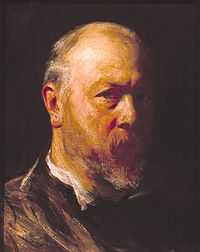John Pettie
| John Pettie | |
|---|---|
 Self-portrait from 1882 | |
| Birth name | John Pettie |
| Born |
17 March 1839 Edinburgh |
| Died |
21 February 1893 Hastings |
| Nationality | Scottish |
John Pettie RA (17 March 1839 – 21 February 1893) was a Scottish painter who spent most of his career in England. He became a member of the Royal Academy in 1866 and a full academician in 1874.[1]
As an enthusiastic amateur musician, he helped the career of the young composer Hamish MacCunn by organizing concerts for him in his own studio. MacCunn, who would marry his daughter Alison in 1888, also served as a model for many of his paintings and sketches in various distinctive occasions.
Biography
John Pettie was born in Edinburgh, the son of Alexander and Alison Pettie. In 1852 the family moved to East Linton, Haddingtonshire.[1] Initially, his father objected to Pettie taking up art as a career, but this was overcome following a portrait by the lad of the village carrier and his donkey.
When he was sixteen he entered the Trustees Academy in Edinburgh, working under Robert Scott Lauder with William Quiller Orchardson, J. MacWhirter, William McTaggart, Peter Graham, Tom Graham and George Paul Chalmers.[1] His first exhibits at the Royal Scottish Academy were A Scene from the Fortunes of Nigel, one of the many subjects for which he sought inspiration in the novels of Sir Walter Scott, and two portraits in 1858, followed in 1859 by The Prison. To the Royal Academy in 1860 he sent The Armourers; and the success of this work and What d'ye Lack, Madam? in the following year, encouraged him to settle in London (1862), where he joined Orchardson.
In 1866 he was elected an Associate of the Royal Academy, and in 1874 received full academical honors in succession to Sir Edwin Landseer. His diploma picture was Jacobites, 1745. Pettie was a hard and rapid worker, and, in his best days, a colorist of a high order and a brilliant executant. In his early days he produced a certain amount of book illustration. His connection with Good Words began in 1861, and was continued until 1864. He painted a portrait of the painter James Campbell Noble RSA and this is exhibited in the Scottish National Portrait Gallery in Edinburgh. He died at Hastings. In 1894 a selection of his work was included in the Winter Exhibition of the Royal Academy. His self-portrait is in the Tate Gallery.
The Nationl Portrait Gallery has four of his works in their collection.
Works
With J. MacWhirter he illustrated The Postman's Bag (Strahan, 1862), and Wordsworth's Poetry for the Young (Strahan, 1863). His principal paintings, in addition to those already mentioned, are:[2]
|
|
Literature
- The book John Pettie, R.A., H.R.S.A. (London, 1908), by his nephew Martin Hardie, gives the story of his life, a catalogue of his pictures, and fifty reproductions in color.
Gallery
-

The design of the Church Army Chapel, Blackheath, was influenced by The Vigil, the spire and east window carrying the same shape and symbolism as the sword in this painting, on exhibition in the Tate Gallery.
-

Jacobites in 1745, (painted in 1874).
-

Self portrait (1881).
See also
- List of Scots
References
- ↑ 1.0 1.1 1.2 Scottish Places. "John Pettie". Scottish Places.info. Retrieved 19 February 2012.
- ↑ Encyclopedia Jrank. "JOHN PETTIE (1839-1893)". Originally appearing in Volume V21, Page 336 of the 1911 Encyclopedia Britannica. Retrieved 19 February 2012.
 This article incorporates text from a publication now in the public domain: Chisholm, Hugh, ed. (1911). Encyclopædia Britannica (11th ed.). Cambridge University Press
This article incorporates text from a publication now in the public domain: Chisholm, Hugh, ed. (1911). Encyclopædia Britannica (11th ed.). Cambridge University Press
External links
 Media related to John Pettie at Wikimedia Commons
Media related to John Pettie at Wikimedia Commons
|